NVIDIA's GeForce GTX 560 Ti w/448 Cores: GTX 570 On A Budget
by Ryan Smith on November 29, 2011 9:00 AM ESTThe Test, Crysis, BattleForge, & Metro 2033
Yesterday NVIDIA launched their first 290 series beta driver - this was intended to be the launch driver for the GTX 560-448, but QA kept it held up longer than expected. In lieu of that we are using 285.62, the WHQL 285 series driver for the GTX 560-448.
For our look at performance we’ll be taking a look at our Zotac card both at NVIDIA’s stock speeds and at Zotac’s factory overclock. For power/temp/noise we’ll only be looking at Zotac’s card – the lack of a reference design means that temperatures and noise can’t be extrapolated for other partners’ cards.
| CPU: | Intel Core i7-920 @ 3.33GHz |
| Motherboard: | Asus Rampage II Extreme |
| Chipset Drivers: | Intel 9.1.1.1015 (Intel) |
| Hard Disk: | OCZ Summit (120GB) |
| Memory: | Patriot Viper DDR3-1333 3x2GB (7-7-7-20) |
| Video Cards: |
AMD Radeon HD 6870 AMD Radeon HD 6970 AMD Radeon HD 6950 NVIDIA GeForce GTX 580 NVIDIA GeForce GTX 570 NVIDIA GeForce GTX 560 Ti Zotac GeForce GTX 560 Ti 448 Cores Limited Edition |
| Video Drivers: |
NVIDIA GeForce Driver 285.62 AMD Catalyst 11.11a |
| OS: | Windows 7 Ultimate 64-bit |
As this is not a new architecture, we’ll keep the commentary thinner than usual. The near-GTX 570 specifications mean there aren’t any surprises with game performance.

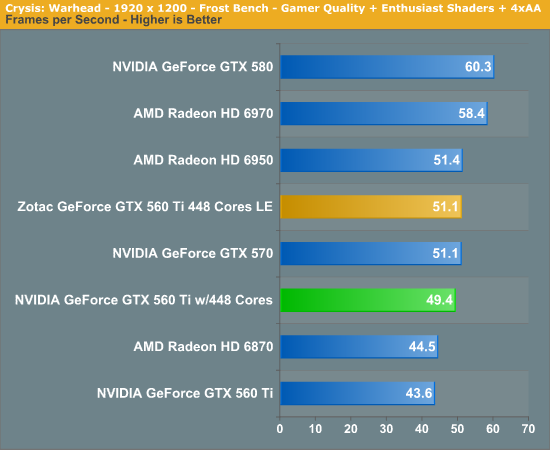
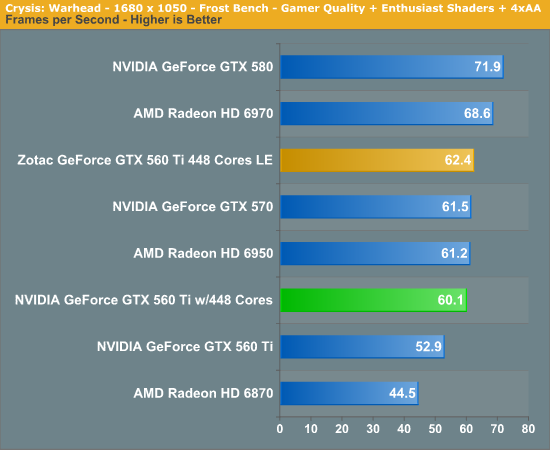
Starting as always with Crysis, at 2560 we can see that while GF100 cards perform decently at 2560, it’s really only the GTX 580 that stands a chance in any shader-heavy game. The GTX 560-448 in that respect is a lot like the GTX 560 Ti: it’s best suited for 1920 and below.
At 1920 and 1680 the GTX 560-448 is well ahead of its GF114-based namesake. As with the specs and architecture, the GTX 560-448 has more in common with the GTX 570 than it does the GTX 560 Ti. The end result is that the GTX 560-448 is just shy of 50fps at 1920, only a few percent off of the GTX 570. With Zotac’s overclock that closes the gap exactly, delivering the same 51.1fps performance. This goes to show just how close the GTX 560-448 and GTX 570 really are. NVIDIA may not want to call it a GTX 570 LE, but that’s really what it is.
Meanwhile compared to AMD’s lineup things are a little less rosy. The GTX 570 at launch was closer to competition for the Radeon HD 6970, but here the GTX 570 and GTX 560-448 are tied by or beaten by AMD’s cheaper 6950.

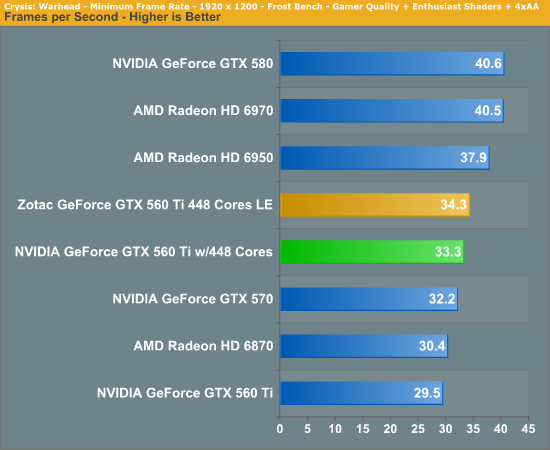

Looking at the minimum framerates we see the same trends. The GTX 560-448 is well above the GTX 560 Ti – by 13% at 1920 – but the 6950 is once again the victor.
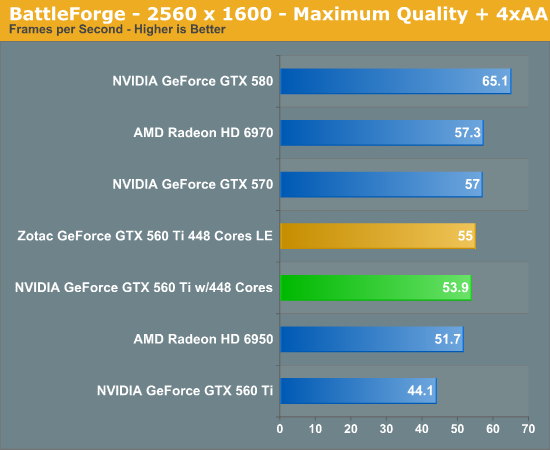


Moving on to BattleForge, we see the emergence of AMD and NVIDIA switching places based on the game being tested. BattleForge favors NVIDIA cards, and as a result the GTX 560-448 does quite well here, tying AMD’s more expensive 6970 at 1920. Zotac’s overclock further improves thing, but as BattleForge likes memory bandwidth, it can’t overcome the GTX 570’s 5% memory bandwidth advantage.


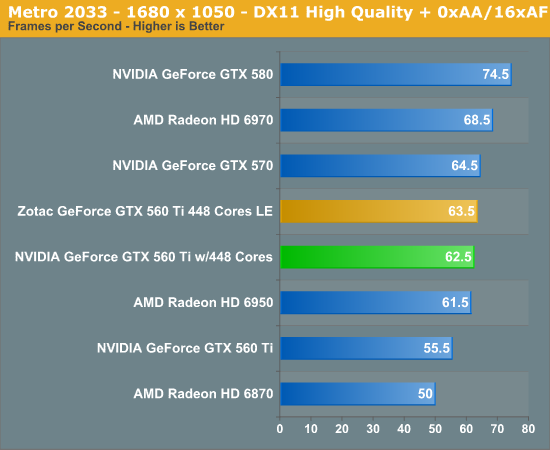
With Metro 2033 we see AMD and NVIDIA swap positions again, this time leaving AMD’s lineup with the very slight edge. This puts the 6950 ahead of the GTX 560-448 at 1920, even with Zotac’s overclock. Practically speaking however you’re not going to break 40fps on a single card without a GTX 580.










80 Comments
View All Comments
Marlin1975 - Tuesday, November 29, 2011 - link
hahahha.... spoken like a true nvidia employee/spokesman/shill.Mathieu Bourgie - Tuesday, November 29, 2011 - link
"Then the issue of microstutter arises which barely affects nVidia hardware, for what can only be presumed to be a ATI driver problem."That's rubbish, Tech Report and Tom's Hardware articles covering micro-stuttering clearly proved that micro-stuttering is an issue on both AMD and Nvidia video cards.
While I'll agree that on average, Nvidia drivers tend to be less problematic, the quality of AMD drivers has improved over the years, aren't as problematic as they used to be and aren't nearly as far behind Nvidia drivers as you paint it.
greylica - Tuesday, November 29, 2011 - link
It's another card based on Ferm(ented) hardware. I will pass by for all of GTX 4XX and 5XX waiting for cards that do respect their own specifications in OpenGL without fails like the well known Nvidia problem about GLReadPixels...Alka - Tuesday, November 29, 2011 - link
Hey, I've seen you're picture before Mathieu. Aren't you the guy who steals the Tom's Hardware best graphics cards for the month format and content? You pass it off as your own on your personal blog, right?Mathieu Bourgie - Tuesday, November 29, 2011 - link
Stealing from their content?If you paid attention to the content of my article and compared it to the content of Tom's Hardware article, you'd notice that my recommendations tend to be quite different from theirs and that they are backed by factual performance numbers coming from various sources, including AnandTech. I also tend to publish my monthly updates before Tom's Hardware do.
Stealing "their" format?
It's like saying that PC makers are copying Apple ideas because "Apple did it first", when Apple didn't do it first. Apple took an existing idea and improved on it and then when some PC makers decided to have their take on the idea, Apple fanboys are crying that PC makers are copying "Apple's idea".
In the past, many other websites, who write about various topics, did "value comparison" articles and did so before Tom's Hardware did theirs. Guess what? Such "value comparison" articles existed before the Internet was mainstream.
The concept that I'm stealing "their" format is as ridiculous as someone saying that website B, who did a review on the latest CPUs, stole website A format because website A were the first to review the latest CPUs.
Alka - Tuesday, November 29, 2011 - link
Dude, you've directly copied and pasted sections of their article without giving credit. That's beyond your own take on a value comparison.Do you really want me to post specific examples of your plagiarism?
Mathieu Bourgie - Tuesday, November 29, 2011 - link
Alka,While I wouldn't be surprised that our articles share some similarities, including similar recommendations, which is to be expected since our articles cover the same products available on the market, accusing me of directly copying and pasting sections of their article without giving credit is taking your comment to a whole other level of disrespect and makes me wonder what's your goal here, if not only trolling...
"Do you really want me to post specific examples of your plagiarism? "
While I'd have no problem listening to you and perhaps making some correction(s) to my article if it possibly looks like someone may think that I could have copied content from Tom's Hardware article, I would rather not do this over this comments section at AnandTech, out of respect for Ryan, Anand and the rest of AnandTech's team, whose articles I truly enjoy and wouldn't want to add a bunch of unrelated comments to their great articles.
I invite you to contact me via:
- The contact form on my website
- Facebook
- Twitter
- Google my name
- Etc.
You have plenty of ways to reach me if you want to further discuss this, without filling this comment section with comments unrelated to this article and without bothering everyone else here.
Thanks,
Mathieu
Alka - Wednesday, November 30, 2011 - link
No point, you've clearly convinced yourself that shameless plagiarism is acceptable without giving proper credit.JonnyDough - Thursday, December 1, 2011 - link
Irregardless of any fanboyism here, or whether or not you steal text,"That's rubbish, Tech Report and Tom's Hardware articles covering micro-stuttering clearly proved that micro-stuttering is an issue on both AMD and Nvidia video cards."
That is truth.
formulav8 - Tuesday, November 29, 2011 - link
One of the most useless and fannish posts on here.